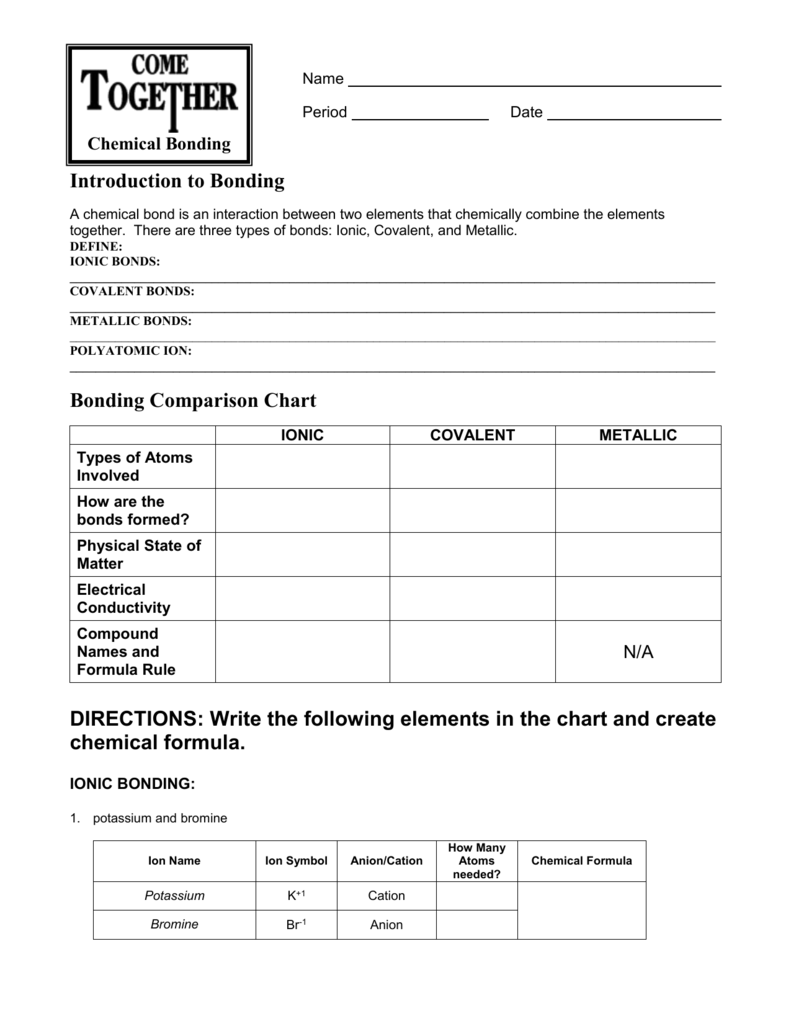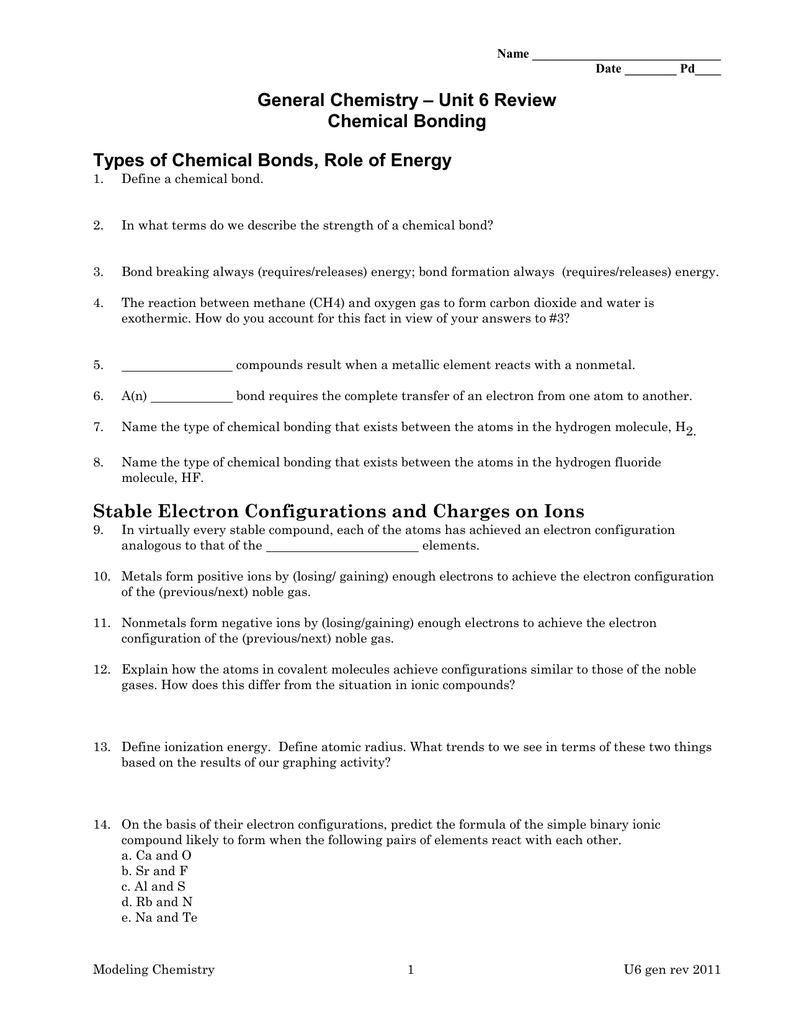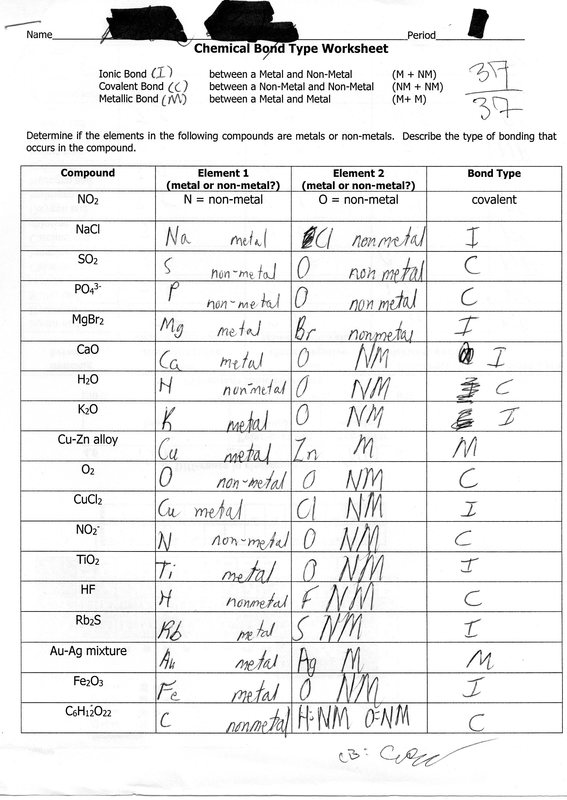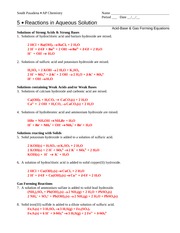39 chemical bond worksheet answers
DNA - The Double Helix, Coloring Worksheet The bases are known by their coded letters A, G, T, C. These bases always bond in a certain way. Adenine will only bond to thymine. Guanine will only bond with cytosine. This is known as the Base-Pair Rule. The bases can occur in any order along a strand of DNA. The order of these bases is the code the contains the instructions. PDF AP CHEMISTRY REVIEW WORKSHEET (Unit 14 Chemical Bonding) AP CHEMISTRY REVIEW WORKSHEET (Unit 14 - Chemical Bonding) 1. List the elements that will form multiple bonds: _____ 2. How many sigma and pi bonds are in the molecule below? _____ sigma bonds _____ pi bonds H H H - C ≡ C - C = C - H 3. Rank the types of covalent bonds (single, double, triple) in order from shortest to longest: ...
How to Write a Chemical Equation (with Pictures) - wikiHow Apr 30, 2021 · Write the chemical symbol for the first element. When a compound has been written out, you must identify the elements and know their chemical symbols. The first element written is "first name" of the compound. Use the periodic table to find the chemical symbol for the element. For example: Dinitrogen hexafluoride.

Chemical bond worksheet answers
PDF Elements and Bonding Worksheet - Answers Elements and Bonding Worksheet - Answers |) Classify each of the following elements as an alkali metal, an alkaline-earth metal, transition metal, metalloid, halogen, or noble gas based on its ... electrons, so there's no particular reason for it to form chemical compounds. 5) Explain why beryllium loses electrons when forming ionic bonds, while Chemical_Bonding-answers - Chemical Bonding Worksheet Ionic Bond ... Classify each of the bonds as either ionic or covalent. (Answers below) a. Al—OI d. Bi—O I g. Na—S C j. Ti—BrC b. Al—S C e. C—ClC h. P—O C k. C—OC c. Bi—ClC f. N—OC i. S—OC l. Sr—ClI 3. What force holds the two ions together in an ionic bond? Electrostatic attractions 4. DOC Come Together: Chemical Bonding Worksheet Atoms form chemical bonds to minimize their potential energy Atoms have high potential energy. Atoms bonded have lower potential energy. What are the exceptions to the octet rule? Exceptions are 1 ) HYDROGEN = 2 valence electrons 2) BORON = 6 valence electrons
Chemical bond worksheet answers. Covalent bond worksheet - Liveworksheets.com ID: 2148080 Language: English School subject: Chemistry Grade/level: grade 10 Age: 16-16 Main content: Chemical Bonding Other contents: Add to my workbooks (21) Download file pdf ... PDF Chemical Bonding Answer Sheet By the way, related with Types of Chemical Bonds Worksheet Answers, scroll down to see various similar photos to give you more ideas. balancing chemical equations worksheet answer key, chemical bonding worksheet answers and chemical bonding worksheet answer key are three of main things we want to show you based on the gallery title. 16 Images ... Chemical Bonding MCQs And Answers PDF - LiveMCQs Chemical Bonding Questions and Answers PDF 1. If the electronic configuration of an element is 1s2 2s2 2p6 3s2 3p6 3d2 4s2, the four electrons involved in chemical bond formation will be_____. 3p6 3p6, 4s2 3p6, 3d2 3d2, 4s2 Answer: 3d2, 4s2 2. The number of types of bonds between two carbon atoms in calcium carbide is Two sigma, two pi 5 MCQ Worksheets on Chemical Bond [MCQ] - Ionic, Covalent, Metallic MCQ worksheet on an introduction to chemical bonds (with answer) - set 1. Subscripts in a chemical formula are used to show the number of. a. molecules in a substance. b. atoms of each element in a compound. c. different elements in a compound. d. protons in an element.
DOC CHEMICAL BONDS WORKSHEET - Loudoun County Public Schools Chemical Bonds Worksheet Choose words from the list to fill in the blanks in the paragraph. Anion covalent bond Chemical bond metal Ionic bond molecule Noble gas polyatomic ion Stable octet valence shell Bond energy electronegativity Hydrogen bond polar molecule Polarity cation Chemical reaction Difference Between Physical and Chemical Change - BYJUS A chemical change is a permanent change. A Physical change affects only physical properties i.e. shape, size, etc. Chemical change both physical and chemical properties of the substance including its composition: A physical change involves very little to no absorption of energy. During a chemical reaction, absorption and evolution of energy ... 1.3 Physical and Chemical Properties – Chemistry Answers for Chemistry End of Chapter Exercises. 2. (a) physical; (b) chemical; (c) chemical; (d) physical; (e) physical. 4. physical. 6. The value of an extensive property depends upon the amount of matter being considered, whereas the value of an intensive property is the same regardless of the amount of matter being considered. 8. 50 Chemical Bonds Worksheet Answers - Chessmuseum 50 Scientific Method Examples Worksheet. 50 Net force Worksheet Answers. 50 Rational Vs Irrational Numbers Worksheet. 50 Acid Base Reactions Worksheet. 50 Dependent and Independent Variables Worksheet. 50 Supply and Demand Worksheet. 50 isotope Practice Worksheet Answer Key.
PDF 6 Chemical Bonding - Somerset Canyons CHAPTER 6 REVIEW Chemical Bonding SECTION 3 SHORT ANSWER Answer the following questions in the space provided. 1. a The notation for sodium chloride, NaCl, stands for one (a) formula unit. (c) crystal. (b) molecule. (d) atom. 2. d In a crystal of an ionic compound, each cation is surrounded by a number of (a) molecules. (c) dipoles. (b) positive ions. (d) negative ions. 3. b Compared with the ... PDF WORKSHEET: Chemical Bonding - Ionic & Covalent! PART 2: Use Lewis dot structures to show the ionic bonding in the following pairs of elements. Show the transfer of electrons using arrows. Write the correct chemical formula for the ionic compound that forms. 1) barium oxide (Ba and O) 4) sodium oxide (Na and O) Formula: Formula: PDF Chemical bonding worksheet 2 answers - CRISTALENSI The e-shared in the middle forms a single bond. 14) 1. Covalent bonds involve sharing electrons between non-metallic atoms. 15) 1. HCl has the biggest difference in electronegativeness between the two atoms resulting in more polar covalent bond. (almost unparalleled sharing e-) 16) 2. PDF Worksheet 13 - Chemical Bonding electron configurations allowed ... The shared electrons form the chemical bond between the F atoms. The other 3 pairs of electrons on each of the F atoms are called lone pair electrons and are not involved in bonding. We represent F 2 as F- F. Each of the F atoms will have 3 lone pairs of electrons and an equal shared in the bonding electrons. 11. Draw the Lewis structure of ...
PDF Chemical Bonds Review Guide Answer Key Created Date: 10/20/2014 11:11:57 AM
Chemical Bond Worksheets Chemical Bond Worksheets Answer Keys Here There are invisible forces that hold atoms together in compounds. There are generally three ways that atoms are stuck together with a bond. In general, when two nonmetal elements form a bond, they equally share electrons and form a covalent bond.
Naming Compounds Practice Worksheet MULTIPLE CHOICE. Choose the one alternative that best completes the statement or answers the question. 81) Which of the following pairs of elements would most likely form a ionic compound? A) Ca and Ni B) Cu and Ar C) F and S D) Zn and K E) Na and Cl 82) Electronegativity is a concept that is useful along with other concepts in _____.
DOCX Lewis Dot Structures Worksheet - Loudoun County Public Schools Chemical Bonds - Ionic Bonds KEY Identify the Number of Valance Electrons and Draw the Lewis Dot Structure Notes: Scientists use Lewis Dot Structures to show the valance electrons of an element as dots. Since bonding involves the valance shell electrons only, it is only necessary to illustrate those outer electrons. Element Group Number (PT)
Chemical Bonding Worksheet Answer Key Pdf - Naturefed Key covalent bonding worksheet answers.ionic bonding is often the outcome of the covalent bond as well. This reaction is shown below. Types of chemical bonds worksheet answers pdf. • boron metalloid • gold transition metal • krypton noble gas • calcium alkaline earth metal Chemical bonding section 1 short answer answer the following ...
Chemical Bonds worksheet - Liveworksheets.com More Chemistry interactive worksheets. Finding number of atoms in a chemical formula. by sriram. Atomic Structure. by sibarani24. Periodic table. by yaneeam. Classify atoms, molecules, elements, and compounds. by LeeChem040.
PDF Chemical Reactions And Energy Worksheet Answers Chemical Reactions And Energy Worksheet Answers Author: donner.medair.org-2022-06-25T00:00:00+00:01 Subject: Chemical Reactions And Energy Worksheet Answers Keywords: chemical, reactions, and, energy, worksheet, answers Created Date: 6/25/2022 11:11:49 AM
Quiz & Worksheet - Chemical Bond Basics | Study.com A material containing ionic bonds only A material containing only non-metals Worksheet Print Worksheet 1. What force causes a chemical bond to hold atoms together? Electrostatic attraction...
Ionic Covalent Key - Ms. K's Chemistry Class Created Date: 3/6/2017 4:38:31 PM
Chemical Bonding worksheets and online exercises Chemical Bonding worksheets and online exercises. Language: English Subject: Chemistry. Order results: Finding number of atoms in a chemical formula. Grade/level: 8. by sriram. Ionic bond. Grade/level: grade 10. by arnida_79.
DOC Chemical Bonding Worksheet - Mrs. Alinger's Science Pages Chemical Bonding Ionic Bond between a Metal and Non-Metal (M + NM) Covalent Bond between a Non-Metal and Non-Metal (NM + NM) Metallic Bond between a Metal and Metal (M+ M) Determine if the elements in the following compounds are metals or non-metals. Describe the type of bonding that occurs in the compound. Compound Element 1
DOC Come Together: Chemical Bonding Worksheet Atoms form chemical bonds to minimize their potential energy Atoms have high potential energy. Atoms bonded have lower potential energy. What are the exceptions to the octet rule? Exceptions are 1 ) HYDROGEN = 2 valence electrons 2) BORON = 6 valence electrons
Chemical_Bonding-answers - Chemical Bonding Worksheet Ionic Bond ... Classify each of the bonds as either ionic or covalent. (Answers below) a. Al—OI d. Bi—O I g. Na—S C j. Ti—BrC b. Al—S C e. C—ClC h. P—O C k. C—OC c. Bi—ClC f. N—OC i. S—OC l. Sr—ClI 3. What force holds the two ions together in an ionic bond? Electrostatic attractions 4.
PDF Elements and Bonding Worksheet - Answers Elements and Bonding Worksheet - Answers |) Classify each of the following elements as an alkali metal, an alkaline-earth metal, transition metal, metalloid, halogen, or noble gas based on its ... electrons, so there's no particular reason for it to form chemical compounds. 5) Explain why beryllium loses electrons when forming ionic bonds, while













0 Response to "39 chemical bond worksheet answers"
Post a Comment